| 8 July |
• yesterday • tomorrow |
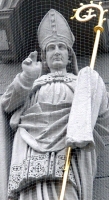
• Apostle of Franconia
• Chilianus, Chillian, Chillien, Cilian, Cillíne, Cillian, Kilian, Killena
Born to the Irish nobility. Monk at the monastery of Hy. May have been an abbot. Travelling bishop throughout Ireland. Missionary with eleven companions through Gaul to Würzburg, Germany whose people he found to be pagan, and whom he resolved to convert. Pilgrim to Rome, Italy in 686 where he received papal authority for his mission; Pope Conon ordained him as a missionary bishop. Kilian then returned to Würzburg in 687 with Saint Colman and Saint Totnan. With them, he evangelized East Franconia and East Thuringia, areas in modern Bavaria, Germany, converted Duke Gozbert and a large part of Gozbert's subjects.
After Duke Gozbert converted, Killian explained that the duke's marriage with Geilana, his brother's widow, was unlawful. He secured the duke's promise to leave her, which made an enemy of pagan Geilana. She plotted against the saint, and caused the murder of him, Colman and Totnan, and the burial of their corpses, sacred vessels, vestments, and holy writings at the crime scene. When the duke returned to her, Geilana denied knowing the location of the missionaries. The actual murderer went mad, confessed his crime, and died miserably. Geilana herself eventually died insane.
Kilian's good work did not long survive him. When Saint Boniface arrived in Thuringia, he found evidence of his predecessor's influence. The relics of the martyrs, after cures had brought fame to their burial place, were transferred to the Church of Our Lady in 743 by Saint Burchard, first Bishop of Würzburg. After Burchard obtained Pope Zachary's permission for their public veneration, they were solemnly transferred, probably on 8 July 752, to the newly finished Cathedral of the Saviour. Later they were buried in Saint Kilian's vault in the new cathedral erected on the spot where tradition says they were martyred. His skull is still preserved, is be-jewelled, and is processed on his feast day. Killian's copy of the New Testament was preserved in Würzburg Cathedral until 1803, and since then has been in the university library.
c.640 in Mullagh, County Cavan, Ireland
beheaded on 8 July 689
• against rheumatism
• against gout
• whitewashers
• Bavaria, Germany
• archdiocese of Paderborn, Germany
• diocese of Würzburg, Germany
• Tuosist, County Kerry, Ireland (staging point for his mission to mainland Europe)
• bishop being murdered with two priests
• bishop holding a crozier and sword
• bishop holding a large sword and standing between two priests
• with Saint Colman and and Saint Totnan
https://catholicsaints.info/saint-killian/
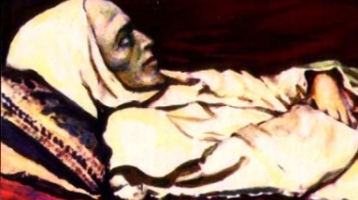
Julio, Julius
Born to the Italian nobility, he received a good education in music, literature and the sciences. As a young man he felt a call to religious life, gave away all he had to the poor, and left home to live as a hermit in the area of Campania, Italy. He and a another hermit, named Giovanni, developed such a reputation for wisdom and holiness that they attraced would-be students, and the local feudal lords built them a hermitage and a church dedicated to the Blessed Virgin Mary. The two hermits wanted the property entrusted to a religious order, so Pope Gregory XIII sent the Camaldolese Benedictines. With the place and the local people cared for by the monks, Giulio withdrew from the area to return to life as a prayerful hermit. With the permission of the monks, he lived near the abbey of Montevergine, but never joined the Order. He served the abbey for 24 years as organist and achieved such a reputation that people came from other cities to hear him during liturgies.
16th century Nardò, Lecce, Italy
• 8 July 1601 at the abbey of Montevergine of natural causes
• buried at his own request under the floor of the Chapel of the Madonna in the abbey so that he would be trampled by all the pilgrims and thus be reminded that he was a great sinner
• his tomb was opened in 1621 during renovations to the chapel, and his body was found to be incorrupt after 20 years
https://catholicsaints.info/blessed-giulio-of-montevergine/

• Sunniva of Norway
• Sunnifa, Synnöve
31 August (translation of relics)
Daughter of a tenth century Irish king. To avoid an arranged marriage with an invading pagan king, she, her brother Alban, and several female companions fled her home to settle in a cave on the island of Selje off the Norwegian coast. Some time later, Viking locals decided that the group was stealing cattle, and sent an armed band to attack them. When they arrived, they found the cave sealed by a landslide; none of the group of exiles were ever seen alive again. Years later, around 995, after reports of strange lights in the area, King Olaf Tryggvason had the cave opened; Sunniva's body was found incorrupt, and the king built a church there in her honour.
Sunniva's story was retold and revised over the years, often combining elements of Saint Ursula's history. Sometimes she is a nun leading a group of pious sisters seeking solitude. According to post-Reformation sources, Sunniva had two sisters, Saint Borni and Saint Marita, and her brother was Saint Alban.
• Bergen, Norway
• Norwegian west coast
https://catholicsaints.info/saint-sunniva-of-bergen/
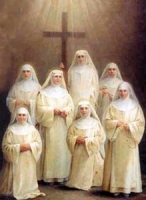
In 1898 seven sisters of the Franciscan Missionaries of Mary were sent to the Shanxi diocese in China to serve the poor in hospitals, and care for the unwanted or other destitutes in orphanages. They were -
• Anne-Catherine Dierks
• Anne-Francoise Moreau
• Clelia Nanetti
• Irma Grivot
• Jeanne-Marie Kuergin
• Marianna Giuliani
• Pauline Jeuris
There they all died in one of the periodic crackdowns against foreign missionaries.
beheaded on 9 July 1900 at Taiyuanfu, China
1 October 2000 by Pope John Paul II
https://catholicsaints.info/martyrs-of-shanxi/
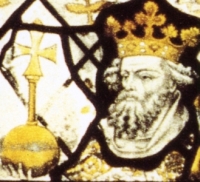
• Eadgar the Peaceful
• Edgar the Peaceable
• Edgar I
• Edgar of England
Born a prince, the son of King Edmund I and Saint Elgiva of Shaftesbury. King of the Mercians and Northumbrians in 957. King of the West Saxons on 1 October 959, which effectively made him king of all England. Efficient and unusually tolerant of local customs; while he spent much time in military actions, his reign was a peaceful period for civilians. Supported his friend Saint Dunstan, Archbishop of Canterbury, Archbishop Oswald of York, and Bishop Aethelwold of Winchester in founding abbeys, encouraged the Benedictine movement, and enacted penalties for nonpayment of tithes and Peter's pence. Father of Saint Edward the Martyr.
943 or 944 in Wessex, England
8 July 975 in Winchester, Wessex, England
• kings
• widowers
https://catholicsaints.info/saint-edgar-the-peaceful/
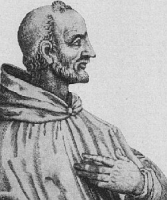
• Peter dei Paganelli di Montemagno
• Bernard of Pisa
• Bernardo Pignatelli
Prominent Cistercian monk. Friend of Saint Bernard of Clairvaux. Abbot of the monastery of Tre Fontaine. Elected pope unanimously on day of his predecessor's funeral; the cardinals wanted a quick election to prevent the interference of secular authorities. Promoted the disastrous Second Crusade. In 1146, the agitation of Arnold of Brescia and the republicans drove the pope from Rome. While in exile from 1146 to 1149 and again from 1150 to 1152, Eugene worked to reform clerical discipline.
at Montemagno, Pisa, Italy as Peter dei Paganelli di Montemagno
15 February 1145
8 July 1151 at Tivoli, Italy of natural causes
28 December 1872 by Pope Pius IX (cultus confirmed)
https://catholicsaints.info/blessed-pope-eugene-iii/

• Pancratius
• Pankratios
• Pancrazio
• Pankratiy
Travelled from Turkey to Jerusalem as a boy during the ministry of Jesus. Back in Antioch, he and his entire family converted. Hermit in a cave in Pontus. Consecrated as a missionary bishop by the Saint Peter the Apostle, and sent to Taormina, Sicily. Miraculously saved the city from destruction by the pagan commander Aquilinus. Martyred by other pagans who opposed Christianity.
Antioch, Cilicia (modern Adana, Turkey)
stoned to death in Taormina, Sicily
• Taormina, Italy
• Canicattì, Italy
elderly bishop holding a cross in his right hand and a Gospel in his left
https://catholicsaints.info/saint-pancras-of-taormina/
Benedictine monk, and prior of Saint Bertin monastery. Alfred of England was impressed with the man's holiness, and when he ascended the throne, Alfred asked Grimbald to come to England to share his knowledge and holiness. Grimbald arrived in England around 885, and impressed many with his knowledge of Scripture, his skill in music, and his holiness. Grimbald helped found the University of Oxford, and served as its first professor of divinity. Declined the bishopric of Canterbury. He retired to Winchester, and with the king's encouragement, he began the foundation of Newminister, and was then installed as abbot. After two decades in England, Grimbald became ill. He took Communion, spent several days in contemplation, gathered the monks of the community to his room for one last time of fellowship, and died.
9th century Flanders, Belgium
901 of natural causes
https://catholicsaints.info/saint-grimbald/
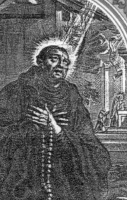
Preached the First Crusade to recover the Holy Lands from invading Muslims. Went with the armies of Godfrey of Bouillon. Vicar General of the Patriarch of Jerusalem. Returned to Belgium in 1099. Founded the Neufmoustier monastery in Huy, Belgium were he served as prior for the rest of his life. Known as a popular preacher and for living an extremely ascetic life; when his relics were moved in 1242 he was discovered to have worn a hair shirt under his habit.
c.1050 at Amiens, France
• 1115 at the Neufmoustier monastery in Huy, Belgium of natural causes
• re-interred in 1242
https://catholicsaints.info/blessed-peter-the-hermit/
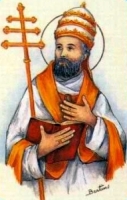
Pope for approximately one year. Almost nothing is known of his life before his ascension. Adrian opposed the Roman aristocratic faction led by the corrupt bishop Formosus, and arrested the more violent members of the group. He died en route to Worms, Germany where he was going to help settle the question of succession to Emperor Charles the Fat.
at Teano, Italy, or Rome, Italy (records vary)
17 May 884
• summer 885 near Modena, Italy of natural causes
• buried in the monastery of Nonantula near Modena
https://catholicsaints.info/pope-saint-adrian-iii/
Five Christians martyred together for their faith. We know nothing else about them but the names - Cecilia, Eperentius, Eraclius, Sostratus and Spirus.
4th century in Syrmium, Pannonia (modern Serbia)
https://catholicsaints.info/martyrs-of-syrmium-8-july/

Prisca
First century Jewish tent-maker. Married to Saint Aquila. Convert to Christianity. Entertained Saint Paul in Corinth and Ephesus. While they lived in Rome, Italy, their house was used as a church. Mentioned in Acts 18; Romans 16; 1 Corinthians 16; and 2 Timothy 4. Martyr.
Rome, Italy
https://catholicsaints.info/saint-priscilla-the-tent-maker/

First century Jewish tent-maker. Married to Saint Priscilla. Convert to Christianity. Entertained Saint Paul in Corinth and Ephesus. While they lived in Rome, Italy their house was used as a church. Mentioned in Acts 18; Romans 16; 1 Corinthians 16; and 2 Timothy 4. Martyr.
Pontus
Rome, Italy
https://catholicsaints.info/saint-aquila-the-tent-maker/
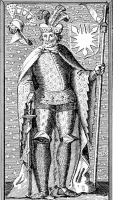
Born to the nobility. Count of Schauenburg, Germany. Conquered the Holstein region of modern Germany from invading pagan Danes in 1225. Crusader to Livonia in 1228. Founded monasteries in Hamburg and Kiel in Germany. Joined the Franciscans in Hamburg in 1239. Ordained in 1245.
• 8 July 1261 in Kiel, Germany of natural causes
• interred in the church of the Franciscan abbey in Kiel
https://catholicsaints.info/blessed-adolf-iv-of-schauenburg/
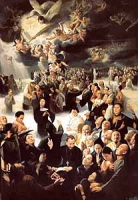
• John Wu Wenyin
• Ruowang
28 September as one of the Martyrs of China
Layman catechist in the apostolic vicariate of Southeastern Zhili, China. Martyred in the Boxer Rebellion.
c.1850 in Dongertou, Yongnian, Hebei, China
8 July 1900 in Dongertou, Yongnian, Hebei, China
1 October 2000 by Pope John Paul II
https://catholicsaints.info/saint-ioannes-wu-wenyin/
Mancio Araki
10 September as one of the 205 Martyrs of Japan
Lifelong layman in the archdiocese of Nagasaki, Japan. Gave Blessed Francisco Pacheco a home during his missionary work. For this he was imprisoned and left to die. Martyr.
c.1590 in Kuchinotsu, Japan
8 July 1626 in Shimabara, Japan of tuberculosis
7 May 1867 by Pope Pius IX
https://catholicsaints.info/blessed-mancius-araki-kyuzaburo/
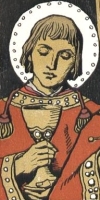
Kolonat
Evangelized Franconia and East Thuringia. Worked and martyred with Saint Kilian and Saint Totnan.
c.689 at East Thuringia
• against gout
• against rheumatism
• whitewashers
https://catholicsaints.info/saint-colman-of-thuringia/
Ythier
Physician. Taught medicine. Treated the poor for free. Chosen bishop of Nevers, France, he became a priest in order to be consecrated.
Nogent-sur-Vernisson, France
• 695 of natural causes
• buried in the collegiate church of Saint Ythier in Sully-sur-Loire, France
https://catholicsaints.info/saint-ithier-of-nevers/

Evangelized Franconia and East Thuringia. Worked and martyred with Saint Kilian and Saint Colman.
c.689 at East Thuringia
• against gout
• against rheumatism
• whitewashers
https://catholicsaints.info/saint-totnan-of-thuringia/
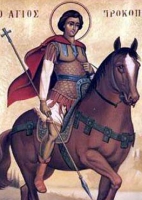
Procopio
Soldier in the imperial Roman army. Martyred in the persecutions of Diocletian for having declared himself a Christian in open court.
beheaded c.303 at Caesarea, Palestine
https://catholicsaints.info/saint-procopius-of-ceasarea/
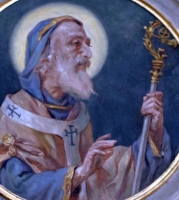
Ampèle, Ampelio
Bishop of Milan, Italy from 665 to 672. Worked to Christianize the invading Lombards.
c.672 of natural causes
https://catholicsaints.info/saint-ampelius-of-milan/

No details about her have survived. She is reported to have appeared in visions in Morwenstow, Cornwall, England where her relics are apparently buried under the church floor.
https://catholicsaints.info/saint-morwenna/
Bearchan, Bracan, Broccan, Brochan
Sixth or seventh century scribe and bishop of Mothil, Waterford, Ireland. May have been the nephew of Saint Patrick, and may have served as his secretary.
https://catholicsaints.info/saint-brogan-of-mothil/
Martyrs of Constantinople
A group of monks in a monstery founded by Saint Abraham of Ephesus. Martyred in the iconoclast persecutions of emperor Theophilus.
c.835 in Constantinople
https://catholicsaints.info/abrahamite-monks/
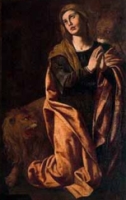
Gliceria
Martyr.
Heraclea, Thrace
https://catholicsaints.info/saint-glyceria-of-heraclea/
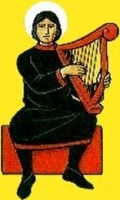
Noted for his charity to the poor. The village Arnoldsweiler, Germany is named for him.
c.800
https://catholicsaints.info/saint-arnold/
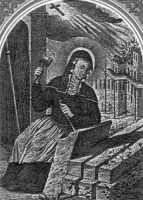
Founded the convent of Munsterbilsen, Belgium and served as its first abbess.
c.690
https://catholicsaints.info/saint-landrada/
Bishop of Benevento, Italy. Forced into hiding during the persecutions of Diocletian.
c.326
https://catholicsaints.info/saint-apollonius-of-benevento/
Spiritual student of Saint Martin of Tours. Evangelist.
• Allonnes, Maine-et-Loire, France
• Verrains, France
https://catholicsaints.info/saint-doucelin/
Bishop. Martyr.
348
sword, the instrument of his execution
https://catholicsaints.info/saint-abraham-the-martyr/
Bishop of Trier, Germany
c.130
https://catholicsaints.info/saint-auspicius-of-trier/
Bishop of Toul, France.
c.475
https://catholicsaints.info/saint-auspicius-of-toul/
• Albert of Genoa
• Anastasius of Ioannina
• Benedict of Alignan
• Disibod of the Rhineland
• Illuminatus of Rieti
• Lorenzo Illuminatore di Farfa
• Nom
• Palmerio of Sardinia
• Peter Vigne
CatholicSaints.Info Portable Edition